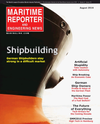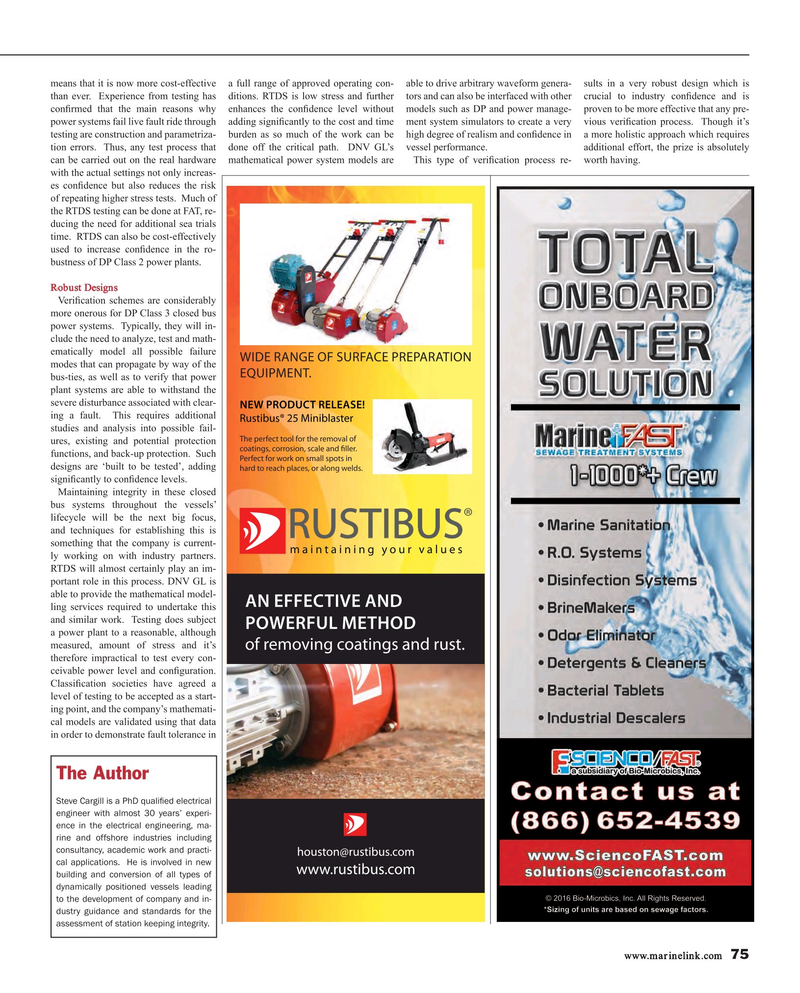
Page 75: of Maritime Reporter Magazine (August 2016)
The Shipyard Edition
Read this page in Pdf, Flash or Html5 edition of August 2016 Maritime Reporter Magazine
means that it is now more cost-effective a full range of approved operating con- able to drive arbitrary waveform genera- sults in a very robust design which is than ever. Experience from testing has ditions. RTDS is low stress and further tors and can also be interfaced with other crucial to industry con? dence and is con? rmed that the main reasons why enhances the con? dence level without models such as DP and power manage- proven to be more effective that any pre- power systems fail live fault ride through adding signi? cantly to the cost and time ment system simulators to create a very vious veri? cation process. Though it’s testing are construction and parametriza- burden as so much of the work can be high degree of realism and con? dence in a more holistic approach which requires tion errors. Thus, any test process that done off the critical path. DNV GL’s vessel performance. additional effort, the prize is absolutely can be carried out on the real hardware mathematical power system models are This type of veri? cation process re- worth having.
with the actual settings not only increas- es con? dence but also reduces the risk of repeating higher stress tests. Much of the RTDS testing can be done at FAT, re- ducing the need for additional sea trials time. RTDS can also be cost-effectively used to increase con? dence in the ro- bustness of DP Class 2 power plants.
Robust Designs
Veri? cation schemes are considerably more onerous for DP Class 3 closed bus power systems. Typically, they will in- clude the need to analyze, test and math- ematically model all possible failure
WIDE RANGE OF SURFACE PREPARATION modes that can propagate by way of the
EQUIPMENT.
bus-ties, as well as to verify that power plant systems are able to withstand the severe disturbance associated with clear-
NEW PRODUCT RELEASE!
ing a fault. This requires additional
Rustibus® 25 Miniblaster studies and analysis into possible fail-
The perfect tool for the removal of ures, existing and potential protection coatings, corrosion, scale and fller. functions, and back-up protection. Such
Perfect for work on small spots in designs are ‘built to be tested’, adding hard to reach places, or along welds. signi? cantly to con? dence levels.
Maintaining integrity in these closed bus systems throughout the vessels’ lifecycle will be the next big focus, and techniques for establishing this is something that the company is current- ly working on with industry partners.
RTDS will almost certainly play an im- portant role in this process. DNV GL is able to provide the mathematical model-
AN EFFECTIVE AND ling services required to undertake this and similar work. Testing does subject
POWERFUL METHOD a power plant to a reasonable, although measured, amount of stress and it’s of removing coatings and rust.
therefore impractical to test every con- ceivable power level and con? guration.
Classi? cation societies have agreed a level of testing to be accepted as a start- ing point, and the company’s mathemati- cal models are validated using that data in order to demonstrate fault tolerance in
The Author
Steve Cargill is a PhD quali? ed electrical engineer with almost 30 years’ experi- ence in the electrical engineering, ma- rine and offshore industries including consultancy, academic work and practi- [email protected] cal applications. He is involved in new www.rustibus.com building and conversion of all types of dynamically positioned vessels leading to the development of company and in- dustry guidance and standards for the assessment of station keeping integrity.
www.marinelink.com 75
MR #8 (74-81).indd 75 MR #8 (74-81).indd 75 8/2/2016 4:14:43 PM8/2/2016 4:14:43 PM

 74
74

 76
76
